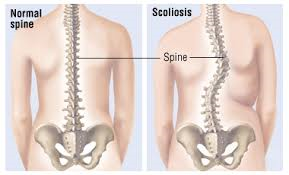 “How could I not have noticed her back was like this before?” a parent asks, “What could I have done?”
“How could I not have noticed her back was like this before?” a parent asks, “What could I have done?”
Almost every parent of a child who is diagnosed with scoliosis utters similar words. It’s a common scenario – a parent unfamiliar with what scoliosis is, how to notice the warning signs in their children, or what to do about it if they do notice something. The fact is, scoliosis is not on people’s radars until it’s too late.
When I was in primary school in Perth, I remember my whole class being checked for Scoliosis by medical doctors. As research into Scoliosis grew, it became clear that it was more a Chiropractic/Neurologocial process rather than a condition requiring medical treatment. So the powers that be took the medical doctors out of school Scoliosis testing. But instead of putting Chiropractors in, they put no one in?! Unfortunately this has resulted in a lot of children with Scoliosis going undetected until they start showing obvious symptoms later in life when it is more difficult to treat.
Here at Karrinyup Wellness Centre, we are dedicated to providing long term health solutions for our families which includes early detection of Scoliosis. As Scoliosis is known to progress around the onset of puberty, it is best to get your child assessed before this age. The spine also tends to reach maturity around adulthood, which is another key time to be assessed by. But it is never too late to be assessed for Scoliosis.
Scoliosis may be going undetected in children and adolescents in your local area, some of which you may already know. The time to screen our children and adolescents in the at risk age groups, is now.
For the first term of 2017 Karrinyup Wellness Centre will be offering Complimentary Scoliosis Assessments for everyone, but especially important for school aged children. It’s time to spread the word. Let’s set the stage for the year ahead, and make early scoliosis detection a focus for all!
Latest scoliosis research shows:
- The prevalence in the at-risk population (children 10 to 15 years of age) is estimated at 2 to 3% [1]
- The prevalence of scoliosis increases rapidly from 11 to 14 years of age [2]
- High rates of scoliosis are observed amongst dancers and gymnasts. Research has shown adolescent dancers are at significantly higher risk of developing scoliosis than non-dancers of the same age [3]
- Early detection delivers more favourable prognoses [4]
- That spinal pain is in fact a prevalent condition in Scoliosis patients, further supporting the need for early detection and screening to minimise potential pain and suffering [5]
As Chiropractors, we are well placed to recognise the early indicators of a possible scoliosis and we also help parents by informing them to be aware of:
- Uneven shoulders
- One more prominent shoulder blade
- Uneven waist line
- A noticeable curve in the spine
- A family history of scoliosis
Dr Barry Smith
Doctor of Chiropractic
Phone Karrinyup Wellness Centre on 9341 3020 or email admin@wellness-centre.com.au for your Complimentary Scoliosis Assessment today!
References
[1] Gutknecht S, Lonstein J & Novacheck T 2009, ‘Adolescent Idiopathic Scoliosis: Screening, Treatment and Referral’, A Pediatric Perspective, vol. 18, no. 4, pp. 1-6.
[2] Sabirin J, Bakri R, Buang SN, Abdullah AT & Shapie A 2010, ‘School Scoliosis Screening Programme – A Systematic Review’, Medical Journal of Malaysia, December issue, vol. 65, no. 4, pp. 261-7.
[3] Longworth B., Fary R., Hopper D, ‘Prevalence and predictors of adolescent idiopathic scoliosis in adolescent ballet dancers’ – Arch Phys Med Rehabil. 2014 Sep;95(9):1725-30. doi: 10.1016/j.apmr.2014.02.027. Epub 2014 Mar 21.
[4] Fong DY, Cheung KM, Wong YW, Wan YY, Lee CF, Lam TP, Cheng JC, Ng BK, Luk KD, ‘A population-based cohort study of 394,401 children followed for 10 years exhibits sustained effectiveness of scoliosis screening’, Spine J. 2015 May 1;15(5):825-33. doi: 10.1016/j.spinee.2015.01.019. Epub 2015 Jan 20.
[5] Theroux Jean, Le May Sylvie, Labelle Hubert [University of Montreal, Quebec, Canada; Murdoch University, Perth, WA, Australia], ‘Back Pain and Adolescent Idiopathic Scoliosis: A Descriptive, Correlation Study’, Spine Society of Australia 27th Annual Scientific Meeting (8-10 April 2016)

